How to Buy the Right Tent for Your Next Adventure
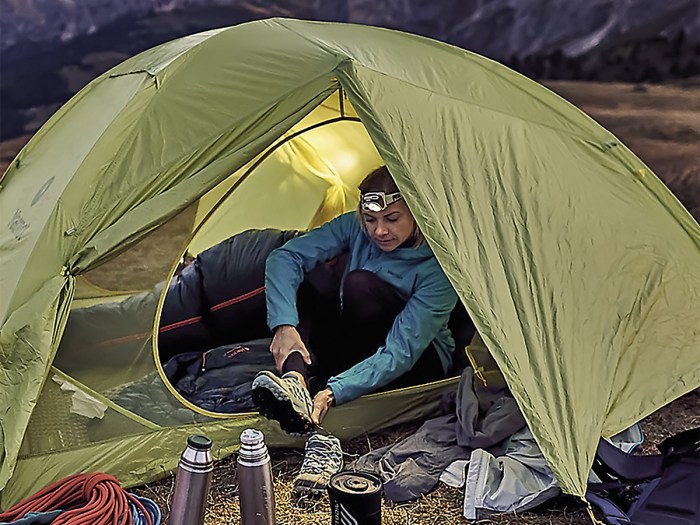
You can sleep under the stars, slip into a bivvy sack or hang a tarp, but if you want a more substantial shelter, get a tent. What kind of tent should you get? Here are come variables and features to consider so you can choose the right tent for your trip.
WHEN CHOOSING A TENT FOR CAR CAMPING, HERE’S WHAT TO CONSIDER:
• CLIMATE. What kind of weather will you be camping in? Four-season tents are designed to withstand strong winds and loads of snow. If you’ll be in milder climates, a three-season tent will do the job.
• SPACE. How many people will share the tent? How much personal space do you all want? Tents can accommodate one, two, three or four sleepers — keep in mind that this label doesn’t consider backpacks or extra gear. It’s helpful to check out the tent at the store before you buy. Ask a salesperson if you can set it up so you can crawl inside and see how much room you’ll have.
Want some headroom? A dome tent might be best because of its design. Think about the ease of moving around, entering and exiting, but also the need to balance a tent’s living space against the following factors.
• WEIGHT. Look especially at a tent’s packed size, considering how much other gear you have to pack. Need something lightweight? Seek out tents specifically
designed for backpacking (see below).
• EASE OF SETUP. Larger tents usually require more time and effort to pitch and take down, which can feel tedious in nice weather and miserable in rain. Think about your tolerance for that versus your desire for more space.
• STABILITY. Tall tents with vertical walls are much more vulnerable to damage from strong winds. Those tents are best for calm weather and campgrounds protected from the wind. Low-profile models with angled walls and guylines are best for all weather. Want a tent that’s sturdy and simple to set up? Look at A-frames.
• RAIN. Some car-camping tents have a rainfly that doesn’t extend to the ground, which is fine for fair-weather camping. Get a full-coverage rainfly for camping in mixed weather; those tents usually have better stability in wind.
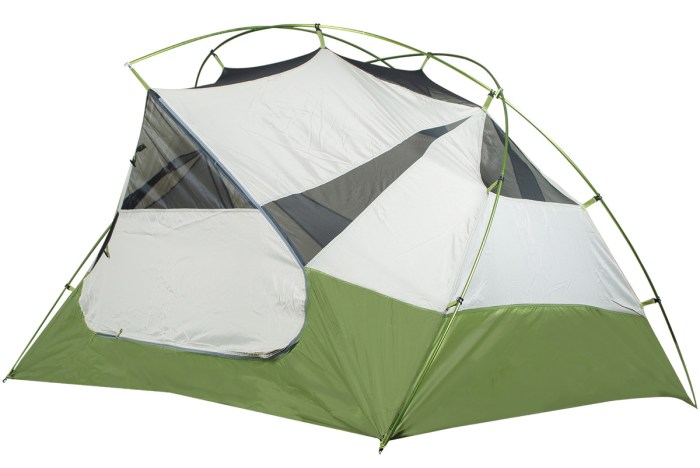
Want one tent for car camping and the occasional backpacking trip? The BSA BASECAMP 3-PERSON TENT ($200, scoutshop.org) hits a nice balance for both purposes at a good price. Designed for backpackers, it sports a hub pole system made of sturdy aluminum that’s similar to many pricier tents, good living space for three people with nearly 40 square feet, and a 41-inch peak height and two doors. For car camping, it will handle windy campsites, pitch and come down easily, and provide livable space, especially for two people. The weight and bulk are reasonable for backpacking. 7 lbs.

For campers who prefer a home away from home, the BIG AGNES BIG HOUSE 4 ($380, bigagnes.com) provides space to stand up (70-inch height) and spread out (57 square feet). Large mesh windows on both doors ventilate the tent, while solid panels zip over them for privacy and warmth. It features smart details like pockets that can also stow the unzipped doors out of the way. The simple pole architecture makes this freestanding tent easy to pitch and allows setting up the partial rainfly as a sun shelter. 11 lbs. 2 oz.
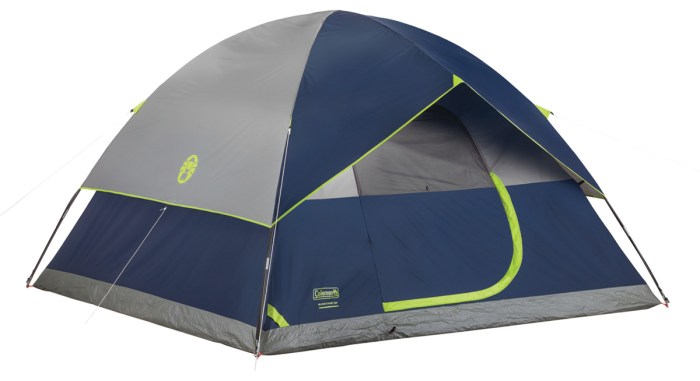
The COLEMAN SUNDOME 6-PERSON DOME TENT ($140, coleman.com) is a good inexpensive choice for fair-weather campers. Measuring 10 by 10 feet with a peak height of 6 feet, this tent could sleep six but offers welcome extra space for fewer occupants — it fits a queen-sized inflatable mattress. It’s easy to set up and doesn’t require a lot of campsite space like some larger tents do. A rainfly that covers the upper half of the tent — along with solid wall fabric on the tent body’s lower half and a waterproof, bathtub-style floor — provides protection against a rain shower, just in case. 16 lbs. 4 oz.
WHEN GETTING A TENT FOR BACKPACKING, YOU’LL WANT TO THINK ABOUT:
• WEIGHT. Pack weight matters and your tent is one of your heaviest pieces of gear, but it also has the most potential for reducing the total weight you have to carry. Many two-person tents weigh less than 4 pounds, and some are less than 2 pounds. Trade-offs for lower weight often include a higher price and less living space and durability.
• SPACE. The interior and vestibule space, peak height, number of doors, and details like vents and pockets all affect your experience. For example, two doors offer more convenience and ventilation than one.
• STABILITY. For backpacking (or car camping) in windy places, look for a more elaborate, sturdier pole architecture and a low-profile, aerodynamic shape.
• SETUP. Freestanding tents are usually easier and faster to pitch and dismantle than non-freestanding. That’s convenient, especially when setting up in the rain. But non-freestanding tents are often lighter and just as sturdy when pitched and staked properly. Tip: The best way to slash tent weight is to get a tent that pitches using trekking poles.
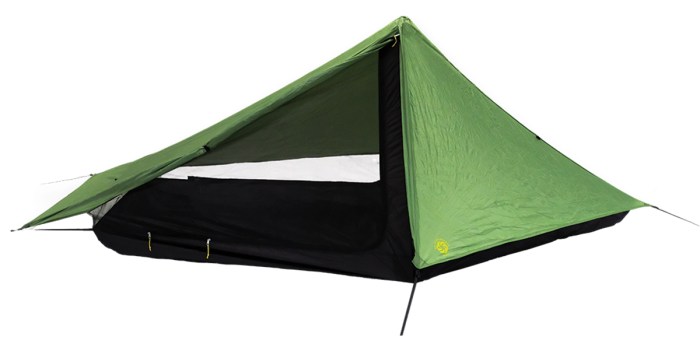
For lightweight backpacking without a heavyweight budget, the SIX MOON DESIGNS SKYSCAPE SCOUT solo tent ($145, sixmoondesigns.com) represents a super value. A hybrid single-wall design pitches using trekking poles (or two tent poles, sold separately) to create a sturdy A-frame. The mesh walls are covered by an integrated nylon rainfly that rolls up to create a bugproof shelter with an almost-unobstructed view of the stars. The 100-inch length, 23 square feet of floor space and 45-inch peak height make it very livable. Downside: It’s a bit bulky. 2 lbs. 8 oz.
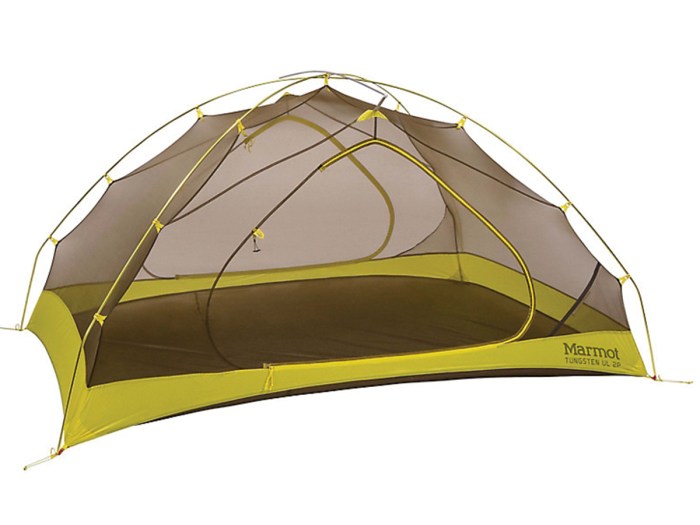
If you place equal importance in a tent’s living space, weight and price, take a close look at the MARMOT TUNGSTEN ULTRALIGHT 2-PERSON TENT ($350, marmot.com). Although just ounces heavier than other models, it sports a spacious 31 square feet — more than virtually all competitors in its weight class. Tent poles bent at the corners and a short eyebrow pole over the top create vertical walls that expand your headroom for a 42-inch peak height. The sturdy pitch shrugs off strong wind, and the two doors and vestibules provide convenience while minimizing condensation. 3 lbs. 7 oz.
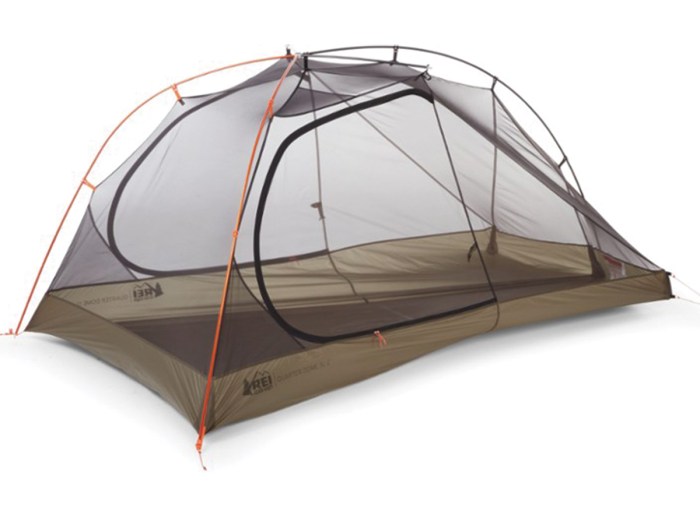
The REI QUARTER DOME SL 2 ($349, rei.com) justifies its popularity by striking a keen balance between low weight and livability. While it’s snug, the trapezoidal floor shape makes it feel roomier than its nearly 29 square feet, and the steep walls similarly enhance the headroom for its 38-inch peak height. The hubbed aluminum poles offer good stability in a quick, semi-freestanding pitch facilitated by color-coded attachments. Two doors and large vestibules improve ventilation and livability. 2 lbs. 8 oz.
I love the idea, but wish the review for “quality” was better… maybe just a tad smaller/less rooms but better material? and I would buy two to make up the difference… great for educational trips to young newbie campers
I’d buy one of these for prepping!
I want a middle room.
that’s cool
i would love one of these
we have large dive groups and this would be awesome
How can a person beta test this tent
I like this tent I think having individual sleeeping areas is grt I dont like rhe fact that all the middle is just open ground it would be better to have floor through out where they can all gather .
The info I found on the Agadez indicates it is not a quality tent. Even if it was, the footprint is 34′ X 17′. That much clear, flat surface just doesn’t exist at a lot of Scout camps or even state and national parks. In the military we often had to use machinery to clear a space large enough for a GP Medium, which is about the same size.
Use a tarp! Maybe a few of them!
This would be perfect for me and what I do.
Very nice how about one full size six twin and one king screen to put a table for food so no flays or ants come in. That would be great.